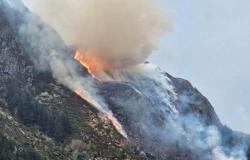Less than 20 minutes ago
From the start it was a race against time.
In November, 11 researchers set out from the Troll research station in Queen Maud’s land. Their findings in Antarctica should help us understand an uncertain danger.
Something is changing, and it can have enormous consequences.
Perhaps primarily for those of us who live in the north.
– It is something we currently have no control over, says Antarctic researcher Tore Hattermann at the Norwegian Polar Institute.
For seven years, measurements from deep under the ice have shown a change. Water warmed up in the open sea far away is carried further under the floating glacier than before.
Today, they have too little knowledge of what happens under the ice, in the layers between the sea and the floating glacier.
– It is sea level rise that we are so concerned about. The world needs the information we find here, says Hattermann.
The sea does not rise if the floating glacier melts, because it is already in water. But the glacier is a kind of barrier that protects the huge ice masses on land.
If the barrier disappears, the ice on land will slide faster into the sea.
The uncertainty about how quickly this can happen means that the UN climate panel cannot rule out that the sea will rise five meters in the next 125 years.
– It is quite violent. I don’t think it will happen myself, but the models today have so little information that it cannot be ruled out, says Hattermann.
The measurements and knowledge his team gathers in the field can help scientists say with greater certainty how fast the world’s oceans will rise.
But to find those answers, the researchers first had to travel 750 kilometers from Troll, out into the icy wilderness.
The sections of ice flow at different speeds and create deep cracks, over which the enormous equipment had to be dragged.
It was ten years ago when researchers last set up camp at this point on Fimbulisen. With a narrow window of time, the demanding job began: melting down through 300 meters of ice.
The big danger was a blizzard, in the ice waste they could see it coming.
The wind swirled so much snow into the air that they had to tighten ropes to find their way to the tents they slept in.
Then the work stopped, for several days.
It could become critical. Once the drilling starts, they cannot stop. The ice works against them.
– It is a constant threat. We must constantly ensure that the hole does not freeze again, says Hattermann.
The researchers also brought something new with them – a remote-controlled underwater robot from the American University Cornell.
Like a large thermometer, the yellow robot was lowered.
– If you want to know how the world is doing, you should put the thermometer in the sea. The air temperature is not that important, says Professor Helge Drange at the Bjerknes Center for Climate Research.
The sea is rising by around half a centimeter a year. Before, it was mostly because the water expands when it gets warm, not because the ice melts. But not anymore.
– Now the pace is increasing and the melting of ice is behind two thirds of sea level rise. It is a very important change that has come in the last ten to fifteen years, explains Drange.
The amount of water stored as ice on land is unfathomable. In Greenland there is enough ice for the sea to rise seven metres, in Antarctica there is enough for 58 metres.
Nobody expects all the ice to melt, says Drange, but increasing melting of the ice caps is a danger we cannot ignore.
– The potential is huge, and it has tremendous consequences for all of humanity, says Drange.
Cities of millions are scattered in coastal zones and along coastlines all over the world.
When the ice in Antarctica melts, the greatest sea level rise will come to us in the northern hemisphere, explains Drange.
– We will notice it more than the average in the world.
Helge Drange
Professor
Photo: Kim E. Andreassen, UiB.
The reason is that the large ice masses around the North Pole and the South Pole have an attractive force, they draw the sea to them and keep it there. If the ice melts, gravity will release the large masses of water.
At the same time, large parts of Norway have a clear advantage in the face of sea level rise, because our country is located on land that is rising. A big exception is the coast along Western Norway, from Kristiansund down to Stavanger you can already see that the sea is rising. Other parts of the coast will notice it later.
– It is a huge challenge, because we have larger and smaller communities all along the coast. Keeping the sea away from all places is a utopia. Building dykes along the entire coast is unthinkable, says Drange.
That is why scientists are watching so closely whether the ice in Antarctica is shrinking.
In West Antarctica, they are already seeing the signs. Some scientists believe it is inevitable that the ice there will disappear, according to an article in Nature.
The same is not the case for East Antarctica, where Hatterman’s team was based. It’s still cold enough there.
– It is in balance, new snow is coming on top while ice is melting on the underside. If this changes and there is more melting than coming in, the amount of ice will change. That is why we are so concerned about this, says Hattermann.
He wasn’t sure what they would find out on the Fimbulis, but the robot had already given him valuable information.
The apparently blurry images of icy water were a big catch for Hattermann.
– It gave us very clear information about what the ice looks like on the underside, where the ice melts, explains Hattermann.
The structure of the surface changes depending on how the ice melts. In some places it looks like golf balls. Other times it resembles the ripples the waves make on sandy beaches.
The various surfaces provide important answers.
– It makes it possible for us to go back and recreate how the ice has melted.
With big grins, they could state that the expedition was a success.
Right now, the measuring equipment is in the ice water and sends him daily e-mails with new measurements.
– The changes here take place slowly over a long period of time, but they cannot be reversed and will have consequences for many hundreds of years. That is why we need this information.
The films and photos in this article were taken by the researchers themselves.
Published: 29.03.24 at 08:46






